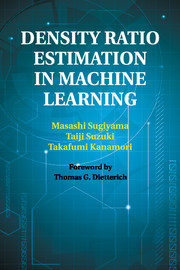Book contents
- Frontmatter
- Contents
- Foreword
- Preface
- Part I Density-Ratio Approach to Machine Learning
- Part II Methods of Density-Ratio Estimation
- Part III Applications of Density Ratios in Machine Learning
- 9 Importance Sampling
- 10 Distribution Comparison
- 11 Mutual Information Estimation
- 12 Conditional Probability Estimation
- Part IV Theoretical Analysis of Density-Ratio Estimation
- Part V Conclusions
- List of Symbols and Abbreviations
- Bibliography
- Index
10 - Distribution Comparison
from Part III - Applications of Density Ratios in Machine Learning
Published online by Cambridge University Press: 05 March 2012
- Frontmatter
- Contents
- Foreword
- Preface
- Part I Density-Ratio Approach to Machine Learning
- Part II Methods of Density-Ratio Estimation
- Part III Applications of Density Ratios in Machine Learning
- 9 Importance Sampling
- 10 Distribution Comparison
- 11 Mutual Information Estimation
- 12 Conditional Probability Estimation
- Part IV Theoretical Analysis of Density-Ratio Estimation
- Part V Conclusions
- List of Symbols and Abbreviations
- Bibliography
- Index
Summary
In this chapter we explain the usage of density-ratio estimation for comparing probability distributions.
In Section 10.1, the pointwise difference of two densities is considered for evaluating whether a sample drawn from one distribution is “typical” in the other distribution. This problem is referred to as inliner-based outlier detection, where the degree of outlyingness of samples in an evaluation dataset is examined based on another dataset that consists only of inlier samples (Smola et al., 2009; Hido et al., 2011).
In Section 10.2, the overall difference of two densities is considered, which basically corresponds to estimating a divergence between two densities. The estimated divergence can be used for a two-sample test, which is aimed at judging whether two distributions are the same within the framework of hypothesis testing (Sugiyama et al., 2011c).
Inlier-Based Outlier Detection
In this section we show how density-ratio methods can be used for inlier-based outlier detection (Smola et al., 2009; Hido et al., 2011). After an introduction in Section 10.1.1, we formulate the problem of inlier-based outlier detection and show how it can be solved via density-ratio estimation in Section 10.1.2. Various native outlier-detection methods are reviewed in Section 10.1.3, and experimental performance is compared in Section 10.1.4. Finally, the section is concluded in Section 10.1.5.
Introduction
The goal of outlier detection (a.k.a. anomaly detection, novelty detection, or one-class classification) is to find uncommon instances (“outliers”) in a given dataset.
- Type
- Chapter
- Information
- Density Ratio Estimation in Machine Learning , pp. 140 - 162Publisher: Cambridge University PressPrint publication year: 2012

